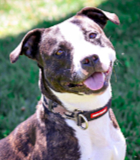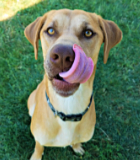New Hope for Canine Cancer
- This topic has 0 replies, 1 voice, and was last updated 15 years, 11 months ago by
Mackenzie’s Admin.
-
AuthorPosts
-
July 2, 2009 at 6:57 pm #438
Mackenzie’s Admin
MemberNew Hope for Canine Cancer
By Karen Asp for The Dog DailyTwo years ago, Buddy the golden retriever hobbled into his veterinarian’s office, barely able to walk. Tests revealed a tumor on the 8-year-old dog’s spine. Buddy’s doctors gave him little hope.
Yet when the plucky dog’s owner, Marti Johnson of Akron, Ohio, learned about an experimental new drug treatment for dogs with cancer, she signed Buddy up. Within six months of daily treatment with nitrosylcobalamin (NO-Cbl), Buddy’s tumor had shrunk by 40 percent, and the most recent test revealed that his tumor has shrunk by 70 percent.
Buddy isn’t alone. Numerous other dogs have experienced similar results from NO-Cbl without any side effects. In fact, the treatment is so effective that its creator hopes the innovative drug can someday help people, too.
How NO-Cbl Works
The name “NO-Cbl” doesn’t exactly roll off the tongue, but it contains just two key components. These are nitric oxide and cobalamin, which is the chemical term for vitamin B12.
For decades, researchers have known that cells, especially cancer cells, have an affinity for vitamin B12. “All cells need B12 to divide and proliferate or they’ll die," says Joseph A. Bauer, Ph.D., NO-Cbl’s creator and director of scientific research with Bauer Research Foundation in Akron, Ohio. He adds that cancer cells are particularly fond of B12. Studies show that when mice are given B12, their tumors are 400 percent larger than afflicted mice that don’t receive B12.
Nitric oxide, on the other hand, does the opposite, encouraging cell death, which is why Dr. Bauer decided to combine the two. He explains that this is the perfect combination because vitamin B12 would lead the nitric oxide to the cancer cells, and once there, the nitric oxide would kill the cells.
How to Get Your Dog on This Drug
Dogs with cancers of all kinds could be candidates for NO-Cbl. “Because of the biochemistry of B12, this drug is effective against all types of tumors,” Dr. Bauer says, adding that cats too are now on NO-Cbl. The one stipulation? Tumors can’t be bigger than 7 centimeters by 7 centimeters.
To get your pet involved, contact Bauer through his research foundation online. You’ll receive a consent form that you and your veterinarian will need to fill out. Your veterinarian must agree to oversee the treatment.
While there is often a waiting list of dozens of dogs, once you’re in the program, your veterinarian will teach you how to administer the drug through injections. Once a month, your dog will also need to undergo a full exam and complete blood work, and every six months, it will also require an MRI scan to check the drug’s efficacy. This data then goes to Dr. Bauer for analysis.
Cancer-free With a Freebie
Although the treatment costs about $24 per day for an average-size dog, owners pay nothing for the drug itself. "The goal my family and I had when starting the foundation was to offer this drug free to pet owners," Dr. Bauer says. He’s currently working with organizations to help fund this research so he can make the drug more widely available.
Because dogs and humans share similar genes, Dr. Bauer hopes that once he collects enough data from dogs, he’ll be able to convince the FDA to run human trials.
As for Buddy, he’s back to enjoying his daily walks and playing with toys. “Buddy is a miracle dog,” Johnson says. “Even our vet has never seen anything like this.” -
AuthorPosts
- You must be logged in to reply to this topic.












































